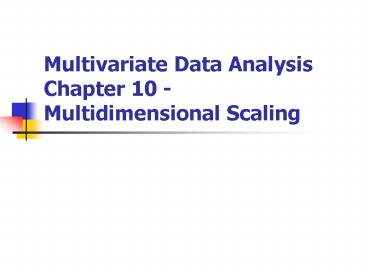Multivariate Data Analysis Chapter 10 - Multidimensional Scaling - PowerPoint PPT Presentation
Title:
Multivariate Data Analysis Chapter 10 - Multidimensional Scaling
Description:
Multivariate Data Analysis Chapter 10 - Multidimensional Scaling Chapter 10 What Is Multidimensional Scaling? A Simplified Look at How Multidimensional Scaling Works ... – PowerPoint PPT presentation
Number of Views:140
Avg rating:3.0/5.0
Title: Multivariate Data Analysis Chapter 10 - Multidimensional Scaling
1
Multivariate Data AnalysisChapter 10 -
Multidimensional Scaling
2
Chapter 10
- What Is Multidimensional Scaling?
- A Simplified Look at How Multidimensional Scaling
Works - Comparing MDS to Other Interdependence Techniques
- Individual As the Unit of Analysis
- Lack of a Variate
3
A Decision Framework for Perceptual Mapping
- Stage 1 Objectives of Multidimensional
- Scaling
- Key Decisions in Setting Objectives
- Identification of All Relevant Objects to Be
Evaluated - Similarities Versus Preference Data
- Aggregate Versus Disaggregate Analysis
4
A Decision Framework for Perceptual Mapping
(Cont.)
- Stage 2 Research Design of Multidimensional
Scaling - Selection of Either a Decompositional
(Attribute-free) or Compositional
(Attribute-based) Approach - Decompositional or Attribute-free Approach
- Compositional or Attribute-based Approach
- Selecting Between Compositional and
Decompositional Techniques - Objects Their Number and Selection
- Nonmetric Versus Metric Methods
- Collection of Similarity or Preference Data
- Similarities Data
- Comparison of Paired Objects
- Confusion Data
- Derived Measures
- Collecting Preference Data
- Direct Ranking
- Paired Comparisons
- Preference Data Versus Similarity Data
5
A Decision Framework for Perceptual Mapping
(Cont.)
- Stage 3 Assumptions of Multidimensional Scaling
Analysis - Stage 4 Deriving the MDS Solution and Assessing
Overall Fit - Determining an Object's Position in the
Perceptual Map - Selecting the Dimensionality of the Perceptual
Map - Incorporating Preferences into Multidimensional
Scaling - Ideal Points
- Positioning the Ideal Point
- Internal Analysis
- External Analysis
- Vector Versus Point Representations
- Summary
6
Decision Framework for Perceptual Mapping (Cont.)
- Stage 5 Interpreting the MDS Results
- Identifying the Dimensions
- Subjective Procedures
- Objective Procedures
- Selecting Between Subjective and Objective
Procedures - Stage 6 Validating the MDS Results
7
Correspondence Analysis
- A Simple Example of Correspondence Analysis
- Calculating A Measure of Association
- Creating the Perceptual Map
- Stage 1 Objectives of Correspondence Analysis
- Stage 2 Research Design of Correspondence
- Analysis
- Stage 3 Assumptions in Correspondence
- Analysis
8
Correspondence Analysis (Cont.)
- Stage 4 Deriving the Correspondence
- Analysis Results and Assessing
- Overall Fit
- Stage 5 Interpretation of Results
- Stage 6 Validation of the Results
- Overview of Correspondence Analysis
9
Illustration of Multidimensional Scaling and
Correspondence Analysis
- Stage 1 Objectives of Perceptual Mapping
- Stage 2 Research Design of the Perceptual
- Mapping Study
- Similarity Data
- Attribute Ratings
- Preference Evaluations
- Stage 3 Assumptions in Perceptual Mapping
10
Illustration of Multidimensional Scaling and
Correspondence Analysis (Cont.)
- Multidimensional Scaling Stages 4 and 5
- Stage 4 Deriving the Multidimensional Scaling
Results and Assessing Overall Fit - Incorporating Preferences in the Perceptual Map
- Stage 5 Interpretation of the Results
- Overview of the Decompositional Results
11
Illustration of Multidimensional Scaling and
Correspondence Analysis (Cont.)
- Correspondence Analysis Stages 4 and 5
- Stage 4 Deriving the Correspondence Analysis
- Stage 5 Interpreting the Correspondence
- Analysis Results
- An Overview of Correspondence Analysis
- Stage 6 Validation of the Results
- A Managerial Overview of the Multidimensional
Scaling Results

